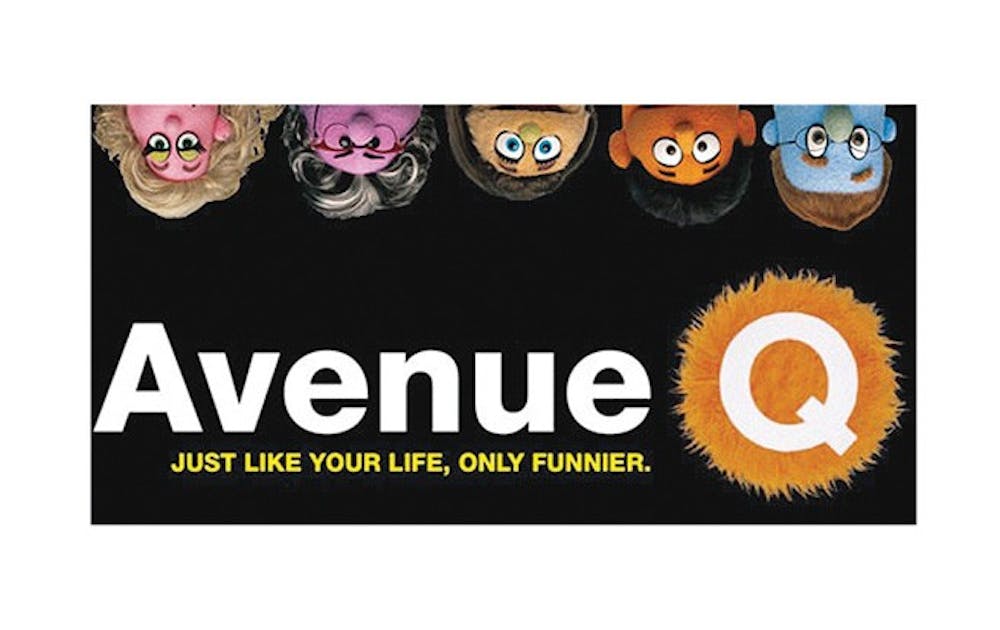There’s an intentional deception behind the work of Hoof’n’Horn’s publicity team in their advertisements for their fall semester musical, Avenue Q; posters guilefully market the show as something innocent and blissfully immature. On their main playbill, a row of Sesame Street-style puppets hover above a banner, arms around each other, flashing open-mouthed smiles. Since the aesthetic of Avenue Q takes implicit inspiration from the Sesame Workshop and Jim Henson’s Muppet franchise, it’s easy to imagine that Hoof ‘n’ Horn’s production will be a gleeful, innocuous jaunt down PBS’s memory lane.
But students unfamiliar with the tone of Avenue Q can set aside concerns about the comedy’s emotional depth. The triple-Tony-winning musical, co-written by Robert Lopez (notable for his contribution to the recent Broadway smash, The Book of Mormon), shocks and disturbs, but nonetheless delights the uninitiated. That is, Avenue Q isn’t so much a perversion of the children’s television theme, but a maturation of it. The musical imagines the puppets of the Hensonian ensemble as if they’ve gone through puberty, finished college and are now having quarter-life crises.
The production also demands an additional layer of expression not inherent in Sesame-style theater; the show calls for live actors to emote alongside their puppets. Freshman Will Gallagher, who controls “Rod,” born out of Sesame’s “Bert and Ernie,” speaks to the challenge of integrating puppetry with ordinary stagecraft. Since much of the cast had little to no experience with the new theatrical medium, the learning curve was steep.
“It was really difficult at first,” Gallagher said. “But you get to a point where you start acting through your puppet, as if you are your puppet, making eye contact with someone through your puppet’s eyes.”
It wasn’t hard to note from Tuesday night’s dress rehearsal that the entire cast had warmed up to their characters in much the same way. Even when I interviewed Gallagher offstage, the connection between actor and puppet was clear; with his right hand, he instinctively matched the motions of his hand to his own dialogue.
Yet the fruits of such strong puppeteer-puppet relationships were clear. Sophomore Melanie Heredia, who works with “Kate Monster,” the hopeless romantic protagonist, discusses a number of advantages to interacting onstage via puppet. As the counterpart to the ironically-named, unemployed “Princeton,” controlled by freshman Robbie Florian, Heredia found that acting through Kate allowed her new communicative modes.
“Robbie and I [as Princeton and Kate] have all these intimate moments, though as actors we never make physical contact,” Heredia noted. “At times it makes it sillier; the puppets can do things that we cannot.”
Yet there’s no loss to honesty in character relations just because the ensemble donates the use of their hands to the puppets (some puppets are managed by two actors at once, a true feat of cooperation that the cast performs effortlessly). Counterintuitively, the use of puppets doesn’t limit the emotional weight of dialogue or its believability.
So how do inanimate representations evoke a potent sense of humanity? Avenue Q is too thematically relevant to its cast and target audience of Duke undergraduates to go unheard. Many of the numbers directly relay the post-university narrative: The show opens when Princeton asks, “What Do You Do With a B.A. in English?”; In the second act, the ensemble laments, “I Wish I Could Go Back To College.”
Heredia explains that drawing on her experience as a sophomore, especially with an undeclared major, helped her connect to the show’s message to everyday life: “The show touches on things that are real: what it’s like to figure out what you’re supposed to be doing with your life, having that feeling of being a little lost.”
Challenges brought by the use of puppets weren’t limited to the actors. Sophomore Mary Kate Francis, who choreographed the show, described the distinct approach she took to blocking dance numbers.
“You have to think in different terms,” explained Francis. “I feel like I’m choreographing two different people. I think about the legs of the puppeteer and the upper body of the puppets.”
Hoof ‘n’ Horn’s production, then, steps into uncharted territory for Duke drama. Torry Bend, an assistant professor in Theater Studies and puppet artist, marked the importance of Avenue Q for Duke’s theatrical development.
“Avenue Q is definitely new for Duke,” Bend wrote in an email. “Most of the puppetry so far in Theater Studies has been in forms such as marionette, bunraku and Toy Theater. The Henson-style hand and arm puppets have a tendency to speak to childhood more directly.”
Other elements of the production’s technical framework have pushed the envelope in terms of Duke’s theatrical exploration. The show makes use of projected media content onto a hanging screen in Shaefer theater. Sophomore Austin Powers, light and video designer for the play, recounts the shift towards use of integrated media.
“There’s a trend of plays being written more cinematically; this trend has been enabled by the use of multi-media in theater,” Powers said. “For Hoof ‘n’ Horn productions in particular, we are breaking new ground.”
Ultimately, the rehearsal process was personally transformative for Hoof ‘n’ Horn participants. Sophomore Mike Myers, who directed the cast of ten (and a much larger crew), recounted how the relationship between actors and their roles was especially strong.
“After the first four weeks or so, we started to meld the two personas, actor and puppet, together,” said Myers. “Then we realized that everybody’s puppets looked like them, and people looked like their puppets.”
Hoof ‘n’ Horn presents Avenue Q October 5-7 and 18-21. Check www.hoofnhorn.org for show times.
Get The Chronicle straight to your inbox
Signup for our weekly newsletter. Cancel at any time.

